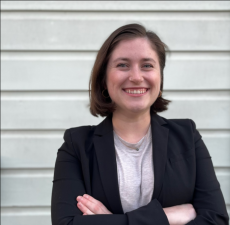Before starting construction, GDPU held a series of meetings with the Head Teacher, construction Contractor, School Management Committee (SMC), and Parent Teacher Association (PTA) to discuss the project and answer questions. Importantly, the SMC and PTA mobilize parents and community members to dig the latrine pit for the project and monitor on-site progress. Gaining their approval and buy-in was vital to the project’s success.
This requirement reminds me a lot of the “sweat equity” vision employed by Habitat for Humanity – to drive ownership of a project by requiring active contributions from the community. The GDPU staff and I have talked a lot about the issues they see with various latrine projects in the District. Challenges include that the community vandalizes the toilet and abuses it on weekends and holidays. The school may let teachers and staff use it instead of students or are just not willing to engage in the maintenance required to keep the toilet operational (I’ll be speaking more to this in another blog on the monitoring of toilets in Gulu District).
Communities need to be involved in the project throughout the design and implementation, so they truly find ownership in the care and maintenance of the latrine after the project handover. This aspect of GDPU’s WASH program design contributes directly towards the sustainability of the project.
The SMC and PTA were eager to approve the project, grateful for GDPU and AP’s presence, and agreed to their responsibilities. As soon as the memorandum of agreement was signed among GDPU, the Head Teacher, the SMC, and the Contractor, the parents began digging!
The pit will need to be 9 meters long, 2.5 meters wide, and 3 meters deep. Over the following two weeks, Emma and I visited Kulu Opal regularly to monitor progress and talk with the parents. In Panykworo in 2023, over 100 mothers and fathers showed up in shifts to help with digging, finishing the pit in a record 5 days. This time, it was a little more challenging to engage parents. But with the drive of the Head Teacher and SMC, a small group of dedicated fathers dug through the layers of rock and dirt to complete the pit.
Skim through the following photos below to see the progress! Now that the pit is complete, the Contractor and his team will take over and begin the construction of the latrine.
Posted By Julia Davatzes
Posted Jul 8th, 2024










3 Comments
Mary Ellen Cain
July 8, 2024
Thank you for the progress report, Julia! And for stressing the importance of having “skin in the game” by the parents and community, exemplified by other organizations such as Habitat for Humanity. It was inspiring to see the commitment of the parents in digging that huge pit in five days, especially through the layers of rock and hard dirt. I look forward to your upcoming blogs describing the other challenges of vandalism and of maintaining the latrines.
Iain Guest
July 10, 2024
Hi Julia, Another very nice blog. I particularly like the time-lapse photos, taken from the same spot! Look forward to seeing the structure arise and emerge. Just one thing missing – the photo of your good self hard at work in the pit! “Sweat equity” is an interesting term but after several school projects I wonder if we’re not a bit starry-eyed about this idea of parental involvement in digging the latrines. It’s conventional wisdom that stakeholders must own development projects, but what can conclusions can we draw from this example. Are the parents who dig really invested and will they stay involved – for example, in helping to keep the facilities in good shape? I’m not suggesting that you investigate, just continue to ask questions and come at this development model from all angles!! Look forward to the next photos…
Bobbi Fitzsimmons
July 19, 2024
I especially liked your inclusion of the dimensions of the pit which has to be dug for the latrine. I had no idea how big this had to be having only seen a finished project in 2022. I certainly hope that those parents who did help will also convince others of the importance of the project and subsequently maintain the structure once the “newness” has worn off.